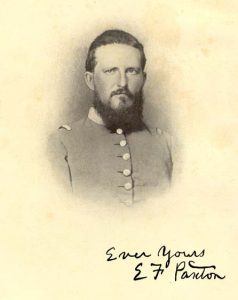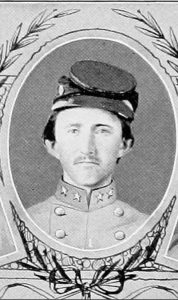More than Just Jackson: The Army of Northern Virginia’s Casualties in the Officer Corps at Chancellorsville
Stonewall Jackson died on May 10, 1863. Ever since, his loss has been held up as a key factor in why the Confederate Army of Northern Virginia was never the same. “If only Jackson…” begins many counter-factuals.
In the wake of Jackson’s death, Chancellorsville has been presented as one of the ultimate pyrrhic victories—Robert E. Lee won, but at the cost of one of his most-trusted subordinates. These statements are nothing new to Civil War scholarship. And yet, usually overlooked in the wake of Jackson’s death is truly how battered the Army of Northern Virginia was coming out of the battle of Chancellorsville.[1]
The battle at Chancellorsville cost Lee’s army in the neighborhood of 13,000 casualties. This translated to 22% of its engaged strength of 60,000 men. Because the majority of James Longstreet’s First Corps was detached around the Siege of Suffolk at the time, the burden of these casualties fell on the army’s Second Corps. Besides the loss of Jackson, the Second Corps had three division commanders and ten brigade commanders killed or wounded (this counting replacement officers who also fell after assuming command).

(“Elisha Franklin Paxton: Memoir and Memorials”)
Perhaps most eye-popping were the regimental officer casualties. The Army of Northern Virginia went into Chancellorsville with 130 regiments of infantry. Over the course of the battle, 56 field grade officers (major, lieutenant colonel, or colonel) heading these regiments were killed, wounded, or captured. Some of those losses came in the same regiment—the 55th Virginia, for example, lost all three of its field grade officers. Across the whole Chancellorsville Campaign, a third of the army’s infantry regiments lost a commanding officer.
While casualties in the army’s other branches were not as pronounced, losses such as the Second Corps’ Chief of Artillery Stapleton Crutchfield and the death of talented battery commander Greenlee Davidson still permeated through the ranks.
Looking at these casualty figures, and focusing in specifically on the regimental commanders reveals the true price for the battle of Chancellorsville. Robert E. Lee may have won, but it came at an exorbitant cost. The battle accomplished very little, and Lee knew that. He snapped at junior officers once Confederate skirmishers realized the Army of the Potomac had escaped across the river on May 6, 1863 that once again the enemy had been allowed to get away. Lee knew that he could not continue to fight the bloody behemoth actions that were marking the war in the eastern theater with no appreciable progress.

(Walter Clark, Histories of the Several Regiments and Battalions from North Carolina, in the Great War, Volume 1)
After the battle was over, Lee was forced to reorganize the Army of Northern Virginia, breaking it from two corps into three. This has always been presented as a way to remedy the loss of Jackson, and that is certainly true, but once more, it is important to realize how deep the scars of Chancellorsville went. Lee did not just lose one of his lieutenants, he lost priceless command experience at the regimental level that would never be replaced. Captains would have to be promoted to field grade and sergeants to company grade to backfill the catastrophic loss incurred by the Army of Northern Virginia. With those new commanders, not just at the top, but equally important, at the bottom, too, Lee would have to fight the battle of Gettysburg in two months’ time.
_________________________________________________________
[1] Numbers for the following post have been attained by a close examination of the order of battle printed in Battles and Leaders of the Civil War, Volume 3 (New York: The Century Company, 1884), starting on 237.
This excellent, detail-oriented scholarship once again demonstrates there are ample opportunities for further consideration of accepted elements of the armies in what for more than a century have been settled consensus. Thank you, Ryan Quint, for an engaging post.
And that’s just the field grade officers. What about the nco’s?
Other Confederate officers in Stonewall’s party were killed or wounded. More were hit by Union fire as they were trying to evacuate Stonewall. Longstreet would suffer the same fate the following year, though he would survive. The “fog of war” can be a brutal thing! The attrition endured by the Confederates at Chancellorsville was absolutely appalling. I ask this, were there any similar situations where Union forces in any particular battle or campaign took so many hits among their officer corps?
In answer to your question, I’d submit the Army of the Potomac at Gettysburg or in the Overland Campaign.
Thanks Chris.
I see the image from Clark’s regimental series and can’t help but think how a decent amount of NC regimental commanders in the last year started so far down the line of succession that they weren’t considered for a photo.
Friends of Wilderness Battlefield (FoWB) researchers are conducting a deep dive into the casualty lists of all of the Confederate units that participated in the 1863 Chacellosville engagement. The initial goal was to possibly identify some of the 10-12 unknown soldiers buried at the Ellwood Divisional Hospital. (1-3 possibles have been idnetified). Very preliminary findings reflect a serious under-counting of the Confederate casualties (compared to existing counts) among the enlisted ranks. There is no firm completion date for the project.
Keep on keeping-on Mr. Epp. A good project.
Thought provoking assessment of the consequences of “victory”
Lee lost at Gettysburg because Joe Hooker’s words were true to the letter. The AOP destroyed most of the leadership of the ANV at Chancellorsville. We don’t have to copy and paste Lost Cause mistruths anymore.
Hooker before Chancellorsville, “May God have mercy on General Lee, for I will have none.” At the conclusion of Chancellorsville, a quote from Lee, “We had really accomplished nothing; we had not gained a foot of ground, and I knew the enemy could easily replace the men he had lost. At Chancellorsville we gained another victory; our people were wild with delight—I, on the contrary, was more depressed.” There should be no doubt in anyone’s mind that the army that Lee faced at Gettysburg was none other than Fightin’ Joe Hooker’s AOP., the same one that Hooker had been perfecting since his appointment as commander on January 26 of that year. The same army that made Lee cry to Pickett “It’s all my fault” . And the same army that beat Lee so badly that he wrote a letter of resignation to Confederate president Davis . Here are the words of a broken Robert E. Lee to Davis on August 8 “I cannot even accomplish what I myself desire. How can I fulfill the expectations of others? In addition I sensibly feel the growing failure of my bodily strength. I have not yet recovered from the attack I experienced the past spring. I am becoming more and more incapable of exertion, and am thus prevented from making the personal examinations and giving the personal supervision to the operations of the field which I feel to be necessary. I am so dull that in making use of the eyes of others I am frequently misled.” Joe Hooker showed no mercy and a broken Lee was trying to quit the game. Meade was not the victor at Gettysburg , Joe Hooker’s army beat Lee. And it certainly wasn’t the shambles of an army that Hooker inherited from Burnside. No,Lee was beaten twice by Hooker, once at Chancellorsville and again at Gettysburg.
Just what does it do to the troops when there has been a death by fratricide? The 18th North Carolina went into a tailspin after Chancellorsville. I am working on the full consequence of the so-called “brilliant” flank attack of Jackson’s. His hubris and lack of caution resulted in the death of some of his good staff. There are monuments to Jackson but few for his staff that were killed with him on May 2, 1863. Jackson never asked about the battle or his men after his wounding. I particularly enjoy the comments made by Confederate based films about Jackson. In their zeal to praise and deify him they fall over each other with contradictions. I would probably not have investigated this if they just left well enough alone and only lionized Lee and Jackson. But the Lost Cause school of thought had to go on and demonize Grant and Sherman. From my experience in business, those kind of lies perpetuate even more lies.
Fratricide results in unacceptable losses and increases the risk of mission failure; it almost always affects the unit’s ability to survive and function. Units experiencing fratricide suffer these consequences:
Loss of confidence in the unit’s leadership.
Increasing self-doubt among leaders.
Hesitancy in the employment of supporting combat systems.
Over supervision of units.
Hesitancy in the conduct of night operations.
Loss of aggressiveness in maneuver.
Loss of initiative.
Disrupted operations.
General degradation of unit cohesiveness, morale, and combat power.
To Ryan Quint –Thank for this work. I apologize if any of my posts appear and do not give proper credit to you. I now have more than 20 sources on Chancellorsville, so I might not give you proper credit. Please keep up the good work . With a 150 year head start, the Mythmakers are ahead, but their negligence and foolishness seems to bury them each time there is new investigation of their tenets.
“Meade was not the victor at Gettysburg”. Lordy, that’s one way to spin it.